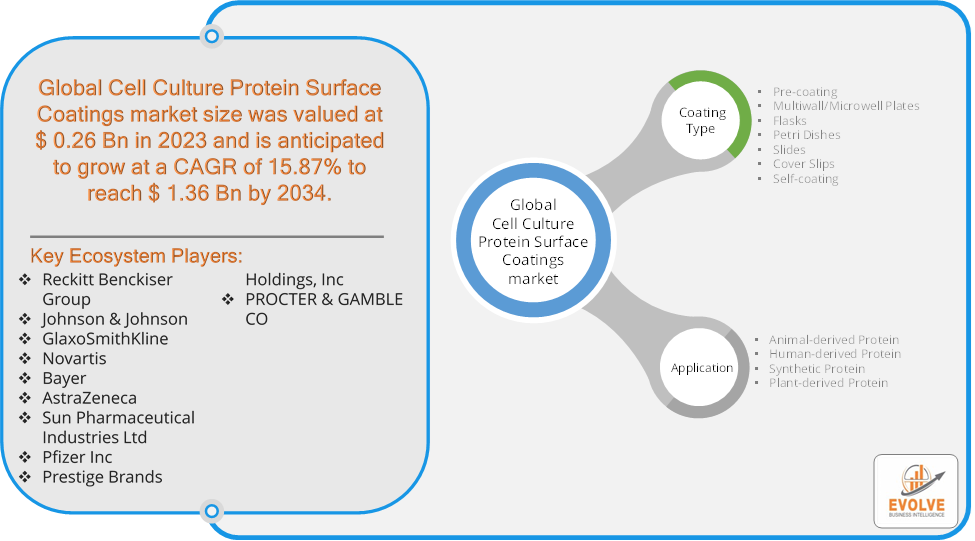Cell Culture Protein Coatings Market Surges: 15.87% CAGR

Evolve Business Intelligence has published a research report on the Global Cell Culture Protein Surface Coatings Market, 2021–2034. The global Cell Culture Protein Surface Coatings market is projected to exhibit a CAGR of around 15.87%during the forecast period of 2021 to 2034.
Evolve Business Intelligence has recognized the following companies as the key players in the global Cell Culture Protein Surface Coatings Market: Reckitt Benckiser Group, Johnson & Johnson, GlaxoSmithKline, Novartis, Bayer, AstraZeneca, Sun Pharmaceutical Industries Ltd, Pfizer Inc, Prestige Brands Holdings, Inc, PROCTER & GAMBLE CO
The Cell Culture Protein Surface Coatings Market size accounted for USD 0.26 Billion in 2023 and is estimated to account for 0.54 Billion in 2024. The Market is expected to reach USD 1.36 Billion by 2034 growing at a compound annual growth rate (CAGR) of 15.87% from 2024 to 2034. The creation and use of specialty coatings that improve the development and functionality of cells in culture are key components of the cell culture protein surface coatings market. The purpose of these coatings is to enhance cell adhesion, proliferation, and differentiation—all of which are essential for a range of scientific and medical applications. They can be produced from synthetic peptides or natural proteins like collagen and fibronectin. Biopharmaceuticals, tissue engineering, and regenerative medicine frequently use them. Innovations in biotechnology and the growing need for cell-based treatments are driving the industry. The use of nanotechnology to improve coating qualities and the emphasis on creating unique solutions to satisfy particular research requirements are two important themes. Companies that specialize in surface modification technologies and biomaterials are important players in this sector.
Download the full report now to discover market trends, opportunities, and strategies for success.
Segmental Analysis
The global Cell Culture Protein Surface Coatings market has been segmented based on Coating Type, Protein Source
Based on Coating Type, the market is segmented based on Pre-coating, Multiwall/Microwell Plates, Flasks, Petri Dishes, Slides, Cover Slips, Self-coating. multiwall/microwell plates dominate due to their widespread application in high-throughput screening and assays, facilitating efficient cell culture and experimentation. The convenience and versatility of these plates make them a preferred choice among researchers in various fields.
Based on Protein Sources, the market has been divided into the Animal-derived Protein, Human-derived Protein, Synthetic Protein, Plant-derived Protein. animal-derived proteins currently dominate due to their widespread use in enhancing cell adhesion and growth, as well as their proven effectiveness in various applications.
Regional Analysis
The Cell Culture Protein Surface Coatings market is divided into five regions: North America, Europe, Asia-Pacific, South America, and the Middle East, &Africa. In this region, Asia Pacific is predicted to expand the most during the study period. Many clinical research institutes and biopharmaceutical businesses are focusing their medication discovery and development efforts in Asian countries such as China and India. Some of the primary drivers encouraging the sector’s growth in this region include the availability of a large genome pool, less severe laws for biologic product development, and increasing healthcare infrastructure. The North America region has indeed emerged as the fastest-growing market for the Cell Culture Protein Surface Coatings industry. The market for cell culture protein surface coatings is dominated by North America due to the region’s heavy investment in the life sciences and healthcare, its strong biotechnology and pharmaceutical industry presence, and its vigorous R&D efforts. The region is a prominent market for protein surface coatings because of its sophisticated infrastructure and emphasis on innovative cell culture technologies.


